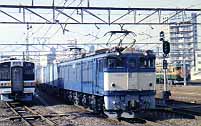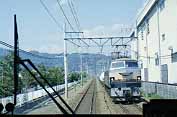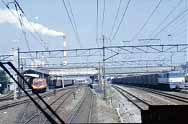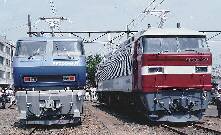
By Hiroshi Naito.

By Hiroshi Naito

By Hiroshi Naito.
Obviously, a positive future for JR Freight demands changes. After
looking at the main problems and suggested solutions, a couple of specific
innovations will be focused on. JR Freight's own 'Freight 21' management
plan has identified the main problems as costs, quality and sales
strategy. Aspects of productivity are positive compared with competing
road freight. Both face load restrictions, but a train may average 650
tons as opposed to a maximum 10 tons for a truck and a train driver can
transport an average 2.1 million tons per year as opposed to 240.000 tons
for a truck driver. However, with Japan still generally using age-related
pay scales, JR Freight's above average age profile (mean = 44.1 years)
means that personnel costs are high. Although nominally down to 9.200 from
the 12.000 transferred from JNR on privatization and way down from the
100.000 concerned with freight in 1964, most of the reduction is the
result of transfer to related companies. Still, at 40% of costs, they are
far improved from the worst JNR period (as high as 133%), not much above
overall JR personnel costs (33%), and better than almost anywhere except US
freight operations. Quality problems are largely related to a change from
heavy freight to light value-added products, with greater pressure for
rapid delivery. Whereas rail's share is high in bulk commodities such as
chemicals and oil, the share in manufactured goods is small. This is
blamed on the speed of freight trains, which have to share congested
routes with passenger trains, plus the time involved in transshipment for
local delivery. Sales is the final area of perceived problems, where JR
Freight is seen as not adapting to local requirements through still being
too unified, as well as leaving marketing to handling agents rather than
pursuing it aggressively.
Upcoming developments mean change is an urgent issue. While financing
of new Shinkansen lines continues to be delayed by government economies,
there seems little such hesitation in the ongoing development of the
expressway (motorway) system, including the forthcoming second Tomei
(Tokyo-Nagoya) Expressway. Aiding this is the low level of opposition to
new roadbuilding compared with Europe. Coastal shipping's strong position
will be enhanced by the development of new high-speed cargo vessels and
lower-cost airlines are poised to enter the cargo market as Japan's air
routes are slowly deregulated.
 |
 |
| Car loaded containers at Kaidaichi station, Hiroshima, by Anthony Robins. |
At a container yard, by Oliver Mayer. |
The lengthy recession, plus the effects of the Hanshin earthquake,
have made such developments even more essential. Several years of losses
have made financial changes urgent. The currently favored plan is to
distribute JR Freight's shares among banks and trucking companies closely
connected to JR Freight. The latter are both rivals and customers of JR
Freight and for example, own nearly one in five of all containers.
Specific Developments:
Just as car traffic has been an important source of freight through the
Channel Tunnel, its reinvigoration was seen as crucial in Japan. While JNR
transported as much as 2.24 million tons of cars annually in the late 1960s
and early 1970s using the 'ku 5000' type double-decker (Kato 8018 model),
this dwindled at a time of frequent industrial action and freight rates
raised to offset JNR's deficit. The Laurel Prize winning 'koki 71' has
been the answer. Operating to carry Toyota cars between Nagoya and
Niigata, an ingenious design using racks enables road and rail use for
easy transhipment. Two racks, each carry either five 1500cc cars (4.2
meters) or four 2500cc cars (4.7 meters). Several key problems are solved.
Long sidings for loading are not needed, greater protection from damage is
provided and most important of all, two 12 feet
containers can be used to carry other freight on the return journey. Speed
capability is 100kms/hr rather than the 75kms/hr of the earlier vehicles.
 |
| An EF200 and a EF500 exhibited at Shin-Tsurumi depot, by Kiyoshi Shinozawa. |
The seven German (MTU) engined DF500s, with an output of 1250kw at 1800rpm,
are a Bo-Bo-Bo design with each bolsterless axle driven individually for
optimum acceleration. More DF500s are currently being delivered. Both
designs, as well as the prototype ED500, EF500 and newest EF210, all have
in common a more robust and powerful look than many JNR electric
locomotives. As a footnote, the EF210 has been in service on Tokyo to
Osaka container trains since November.
JR Freightwatching:
 |
| Shunting opartion in Shiohama freight yard, by Oliver Mayer. |
The breadth of bulk commodity trains is narrowing. For example the
final ED62 operation at the northern end of the Iida Line ceased in autumn
1996. However, Hachioji and the Hachiko Line northwards from there to
Takasaki remains a good location for DD51s hauling cement trains. DD51s
are also active on the scenic Mine Line (Yamaguchi Prefecture) hauling nine
daily limestone trains. Double or even triple-headed EF64s operate tanker
trains over the similarly scenic Chuo (West) Line to Minami-Matsumoto.
 |
 |
 |
|
An EF65-hauled freight train on the Tokaido line. By Oliver Mayer |
An EF81-hauled freight train on the Joban line. By Oliver Mayer |
An EF64-hauled freight train on the Nambu line. By Oliver Mayer |
Other Operators:
Freight carried by the traditional private railways continues to decline,
with Joshin in Gumma (September 94), Echigo Kotsu's Nagaoka Line (March 95)
and Seibu's remaining flow (May 96) among recent abandonments. However,
companies which continue to operate freight services include Kosaka
Smelting in Akita (tankers), Kashima in Ibaraki (tankers) and Sangi in Mie
(cement). In the first case, passenger services have ceased. In addition
a major raison d'etre for one third-sector company, Tarumi in Gifu
Prefecture, is cement. More widespread are the coastal railways mentioned
in part one of this feature which were set up in the 1960s to serve newly
developed industrial areas, from Kushiro in Hokkaido to Kurashiki in
western Honshu. Their shareholders include JR Freight and local port
authorities. Only two also operate passenger services and although their
freight traffic is down from its peak, they fill a vital role in
transhipment to JR lines. The Nagoya Rinkai (Coastal) Tetsudo saw traffic
fall from 2.520.000 tons in 1975 to 1.430.000 tons in 1991. It has the
largest fleet of any of the coastal railways, made up of typical 35 and 55
ton diesels, including former JNR DD13s. There are approximately twenty
daily workings from Kasadera yard on the Tokaido Line, where JR Freight
locomotives take over. Neighbouring Kinu-Ura Rinkai Tetsudo's trains
operate partly over JR metals (Taketoyo Line) to reach the Tokaido Line.
Variety remains!